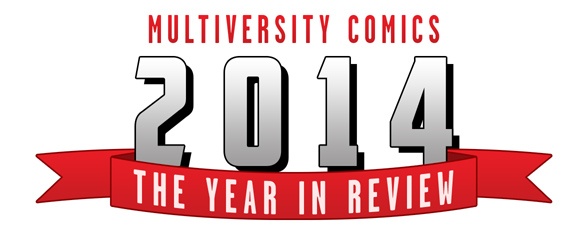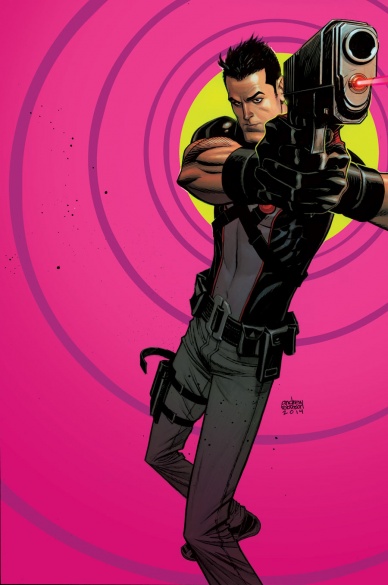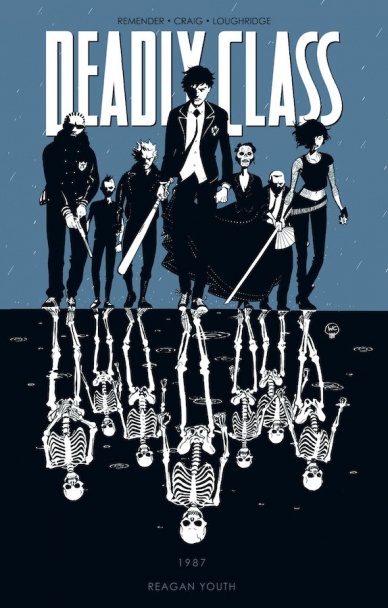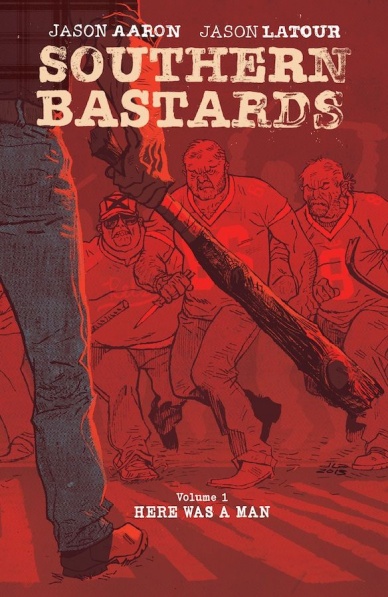
With the deluge of relaunches, reboots and creator-owned books arriving each and every year, Best New Series has somehow become one of our most competitive categories. Image by itself produces enough to fill our entire ranks, and when you factor in publishers like Marvel, DC, Dark Horse, Boom!, Dynamite and more, our cup runneth over with potential options for this category.
But that’s not your problem, that’s our problem, and what you find below are Multiversity’s selections for the five best new series of 2014. We have no doubt you’ll have strong opinions about this, and we encourage you to go to the comments and join the discussion, as there are a lot of great new titles to celebrate this year.
Note: All of Multiversity’s 2014 in Review awards are based off of all of the contributing writing team voting to decide each rank. Every list is combined with equal points for every voter, and the results are what you find below.
Looking for the rest of our 2014 in Review entries? Find them all here.

5. Grayson
Why it made the list (Matthew Garcia): Emerging from that mess known as “Forever Evil”, “Grayson” has found Dick trading his Escrima sticks for pistols to infiltrate the counter-intelligence organization known as SPYRAL. The book centers on several of his spy missions, as well as his developing relationship with fellow operative, Helena Bertinelli. Mostly, though, it’s about Dick trying to stay true to his self and wonder what it means to be a hero as the world around him keeps getting more and more confusing and muddled.
Secret Agent Dick Grayson could have gone any which way, and it was easy to be cynical about its direction under the current DC editorial guidance, but Tim Seeley, Tom King, Mikel Janin, and Jeromy Cox luckily have a strong understanding of the character to help keep the series focus, grounded, humorous, and still true to Dick Grayson. And, with each passing issue, they’ve become more comfortable working together and working with their characters. King also spent some time as a counterintelligence officer for the CIA, and his experience helps add a sense of authenticity to the series. Make no mistake, the book has far more to do with the Mission: Impossible and Bourne movies than The Spy Who Came in From the Cold, but the way the characters talk and interact with each other and joke feels right. Add Seeley’s adept plotting and character work and Janin’s fluid and energetic artwork, not to mention his strong staging for the action sequences, and I’m stoked anytime this book appears on my pull list.
Oh, who are we kidding? Dick frequently takes off a lot of his clothes and jumps and bends and twirls around and — is it getting hot in here or something?

4. Shutter
Why it made the list (David Harper): What do we look for in a new comic? For me, there are the obvious things. The characters you connect with. The dialogue that entrances you. The great concept. The beautiful art. The visual storytelling. These are things you want when you pick up a comic for the first time.
But for me, the biggest thing I look for is the hook. What is it that hooks me in that issue that tells me “I have to get that next issue!”? That by itself can be the difference between a well-crafted comic I try out and don’t think of again, and a book that ends up on my pull list each and every month.
In “Shutter”, the whole damn thing was a hook. The last page of issue one is the obvious one (Kate has siblings?!), but the incredible usage of space (“Shutter” expertly uses the inside front cover in a way few books do), the unbelievably evocative world Joe Keatinge, Leila del Duca and Owen Gieni create, and the phenomenal character work are hooks unto themselves. By the time you were done with that first issue, you didn’t want to just read about this story and its world. You wanted to live in it.
Continued belowSo why was “Shutter” one of the best new titles of 2014? Well, because I can’t live in that world. But thanks to the creative team’s tireless efforts, I do get pretty amazing visits every month or so.

3. Deadly Class
Why it made the list (Mike Romeo): Between Wes Craig’s character work and page composition, Rus Wooton’s letters and masthead, and Lee Loughridge’s colors, Deadly Class has got to be one of the best designed comics on the shelves right now. Every inch of this book is dynamic without being overstated. Craig is unafraid to push all of the panels to one side, using negative space to help tell the story. Or he’ll skew the gutters, creating diagonal lines on the page that the characters seem to slide down against their will. And speaking of characters, holy smokes this has got to be the best looking ensembles in comics. Everyone is so stylized and iconic, but always instantly recognizable. Of course, all of Craig’s work would fall apart with the wrong colorist. I can see how it’d be easy to want to make this a dark book, but Loughridge goes in the opposite direction. A lot of these pages use a monochromatic palette with splashes of accent colors. This approach allows Loughridge to add to the narrative, pushing readers to feel the scene on a more intuitive level. Greyish blue scenes are cool and relaxed, yellows feel anxious, stuff like that. And then Wooton comes in with those squared-off, longer than usual word balloon tails. This seemingly minor detail helps to cement the overall look and feel of the comic. It’s all pitch perfect.
So what about the writing? I think that of all the titles Rick Remender has written this year, Deadly Class is head and shoulders above them all. I can see how it’d be easy to get caught up in the big trope that encases the whole thing. Special kids at some secret boarding school, we focus on the group that causes trouble, mysterious headmaster, etc. But that’s just the framework Remender hangs the story on, it’s not at all what it’s about. This is a story about an age where it’s easy to feel lost in the struggle for identity. These characters are transitioning from one stage of their lives to the next and have no idea what’s waiting for them on the other side. All of this is complicated by the fact that they’re not afforded the opportunity to consider their own futures. No one in this cast knows what next month will look like for them, so how can they ever fathom what life will be like in five years? All of this is compounded by the fact that they have no one to guide them. No one that cares for them, anyway. So they look to each other. Each sees their own problems reflected in one another, so bonds are formed. This is a comic about stray kids who, in the absence of blood relatives, have cobbled together a new family. Deadly Class feels like Remender’s most personal work to date. It feels like a story he cares deeply about telling, and it shows in the quality of the comic.

2. The Wicked + The Divine
Why it made the list (James Johnston): When “WicDiv” was first announced, Kieron Gillen talked about how he began writing the initial draft on New Year’s Eve 2013. He mentioned (and I am definitely paraphrasing here) that 2013 had been a dreadful year and, in many ways, “WicDiv” was an attempt to depart from what made 2013 so awful. It was to be a testament to a new year and so Gillen, Jamie McKelvie, and Matthew Wilson, alongside Clayton Cowles, Hannah Donovan, and Chrissy Williams, did just that. They made a gorgeous comic, one of the most visually stunning on the shelves. One full of witty and stylish characters with a rich mythology. One that wasn’t afraid to hide its influences, from early 90’s Vertigo to Lord Byron to fucking Girls Aloud. Here is a comic that is so undeniably secure in its own identity that it refuses to be held down by the anxieties that were prevalent during “Phonogram” and “Young Avengers”.
Continued belowThat’s not to say “The Wicked + The Divine” moves without insecurities. Hell, it’s taken the idea of a fatal flaw to very, uh, fatal consequences. But where previous collaborations like “Phonogram” and “Young Avengers” (especially “Phonogram”) occasionally felt lost and self-conscious, “WicDiv” dances on, proud that someone’s watching. Sure, Luci and Laura are just as lost as David Kohl or Billy Kaplan, but in the space between collaborations Team Phonogram has found a confidence that simply possesses their latest work. “The Wicked + The Divine” combines the art house sensibilities of “Phonogram” with the high-octane emotion and action of “Young Avengers” to create the team’s first true blockbuster. Each issue is a punch in the gut, and Team Phonogram has found the strength to make each impact last.
If you’ve read “The Wicked + The Divine”, you probably know why we like it. If you’ve read our site, then you definitely know why. I’ll admit that this write-up of the series has been rather self-referential to the creators’ previous work but it’s honestly not that hard to get into. If you can appreciate smart characters, smart design, and just smart comic books, then you can appreciate “The Wicked + The Divine”. And if you’re a fan of any of the creators’ previous work, you can definitely appreciate a book that is without a doubt a step up for all involved; A proud and confident step into what was once a new year. Now, we can’t wait to see what “The Wicked + The Divine” has to bring into the next year.

1. Southern Bastards
Why it made the list (Matt Dodge): Heroes and Villains. These are the two basic archetypes that define comic books. Within the first two dozen pages of “Southern Bastards”, Jason Aaron and Jason Latour create two compelling characters who fit these roles perfectly. In one corner, Earl Tubbs, with a gruff personality and slight anti-hero disposition, and in the other, Coach Boss, the embodiment of small town greed and corruption run amok. It seems familiar, and it is, until the whole thing goes straight to hell.
What makes “Southern Bastards” is that it takes things that seem infinitely familiar and twist them into something dangerous. Small towns, old men, football, even barbecue; there’s nothing that Craw County can’t corrupt. This series creates a new world that uses characters, not flash, to draw readers in, even as they want to avert their eyes.






